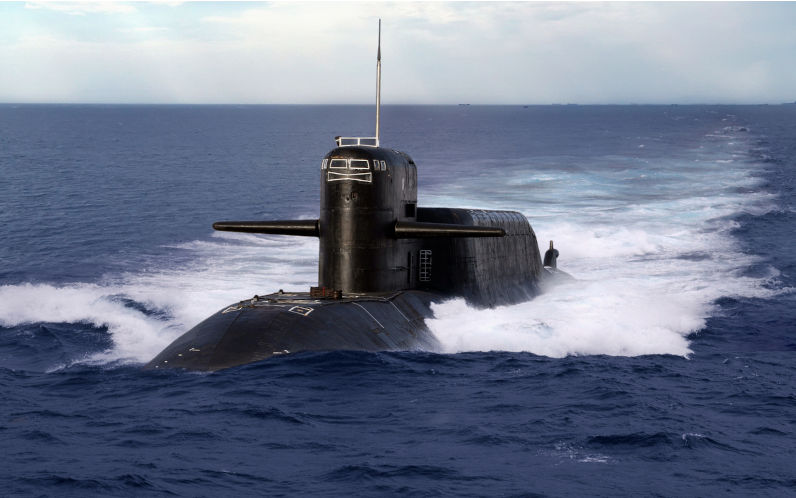Why submarines? The submarine’s most fundamental, key feature is its stealth. A well-handled, submarine is able to operate without causing fuss, in areas where we do not control the sea or air and gain access to areas denied to more overt platforms, such as ships, aircraft and unmanned aircraft.
Long-range submarines are able to operate at great distance for weeks, carrying a flexible payload of sensors, weapons and specialist personnel.
A capable submarine force, either conventional or nuclear powered, creates great uncertainty for an adversary; countering them is difficult, expensive and a solution cannot be guaranteed.
In the surveillance role, submarines are able to operate covertly, avoiding a diplomatic incident, whilst simultaneously observing activities acoustically, visually and over the electromagnetic spectrum, often in areas denied to other eyes and ears. The submarine’s crew are able to interpret what they observe and to position for maximum effectiveness.
The surveillance capability of the submarine cannot be replaced by aircraft, satellites and unmanned aircraft. Submarines complement those systems which often do not cover the full range of spectra. These overt platforms can be observed or predicted, enabling sensitive activities to be curtailed whilst they are present.
In the land strike role, a submarine’s stealth enables it to covertly position precision, land-attack missiles, without causing a diplomatic incident, retire if not required, or launch and withdraw. However, a submarine in this role is limited by the number of missiles it can carry and the time taken to return to base to be reloaded.
Strike is a long way up the spectrum of conflict. In situations short of conflict, Australia’s submarines are able to provide unique indications of another’s long-term intentions, facilitating counter-measures via diplomacy and force preparation that will, hopefully, avoid an escalation to conflict.
Australia is an island, critically reliant on the sea for transporting goods essential for our survival and prosperity – without the sea Australia stops! The sea is a valuable protection, as we have no land borders with another country. At the same time, the sea offers transport for an enemy able to exploit it.
Australia’s 2024 Defence Strategy discusses our strategic environment and what we must be able to do to defend ourselves, including to:
- Shape Australia’s strategic environment;
- Deter actions against our interests; and
- Respond with credible military force when required.
We need to look for capabilities that will give future Australian Governments options to cope in this emerging situation – and submarines fit the bill. A capable submarine will be able to operate in these difficult strategic circumstances and provide a “strategic impact” that would make a potential aggressor avoid a military confrontation with Australia.
Why nuclear power?
Nuclear-powered submarines use controlled fission in the reactor to heat water, creating steam to power the submarine. The reactor has fuel for 10 to 30+ years, depending on its design. This gives a nuclear-powered submarine a huge advantage in mobility and endurance. They can operate at high speed, for as long as their commander wishes, covering long transits at up to three times the speed of the conventionally powered submarine, without needing to expose masts to run the diesel generators and recharge batteries.
These characteristics allow a nuclear-powered submarine much greater freedom, able to reposition quickly, evade searching forces and the initiative to home onto another submarine or ship, maintain contact and attack if desired. The sinking of the Argentinean ship, the Belgrano, during the Falklands war in 1982, by a British nuclear-powered attack submarine, is an example of this capability. As a result, the Argentinean Navy returned to harbour and played no further role in the conflict.
The significant advantage in mobility, stealth and survivability that nuclear power confers justifies the additional cost and management overhead, compared to conventionally powered submarines.
How do air independent powered submarines compare?
The term is used to describe a conventional submarine fitted with a fuel cell or other closed cycle engine, able to generate electricity using stored hydrogen and oxygen, without access to external air. Once the these fuels are exhausted, the submarine has to return to harbour to refuel. This gives the submarine extended endurance, say 10-14 days at slow speed, without needing to expose itself. Higher speeds will draw power from the main storage battery and quickly exhaust it.
These systems are complex, expensive and take up significant space/weight. They are of little use during a transit, where the submarine wishes to move as fast as possible to an operating area. To do this, a conventionally powered submarine relies on a large main storage battery and high-powered diesel generators to recharge it. AIP technology is well suited to nations whose submarines patrol close to home. Given Australia’s geography and need for long transits, it has been judged that the space and weight of an air independent propulsion system is best occupied by a larger battery and more powerful generators for recharging it. In this situation, nuclear power is the ultimate form of air independent propulsion.
Submarines in defence of Australia
A force of submarines, preferably nuclear-powered, on each coast is just what Australia needs to keep track of intruding task groups, able to respond to any hostile action they may initiate. The recent use of a nuclear submarine to warn off a Russian intelligence gathering ship surveying the UK’s underseas cables is an example.
Can drones replace submarines?
Drones offer the potential to undertake surveillance and a range of other tasks, including attack. Submarine motherships, using drones, can extend their reach and reduce risks. However, drones alone lack the range, speed, ability to interpret and react to an unfolding situation and communicate it back to base that the manned submarine offers.
Is the ocean about to become transparent, rendering submarines obsolete?
Surveillance technology backed by computing power is improving, but claims that the ocean will become transparent any time soon overstate the case. Submarines will remain difficult to detect, track and attack, offering unique attributes compared to surface ships or other overt platforms. That is why all maritime powers continue to sustain their submarine force.
Summary
Australia is an island and therefore her borders and supply lanes must be defended by sea.
Submarines offer an excellent platform for achieving effective monitoring, deterrence and attack as a last resort, if required.
Their stealth enables access that confers significant initiative in the complex strategic environment ahead. Submarines are best employed proactively to exploit this advantage; where appropriate, they should be employed offensively to maximise the benefits gained from this attribute.
Submarines are the only weapons system in Australia’s defence forces with this characteristic. They offer a unique range of options for future Australian Governments.

Peter Briggs
Rear Admiral Peter D Briggs AO(Mil) OAM CSC RAN Rtd Peter had a 40 year career in the Navy specialising as a submariner, including two submarine commands. He is a past President of the Submarine Institute of Australia and led the Silent Anzac project to protect, preserve and tell the story of HMAS AE 2. More recently he led the successful search to find and examine HMAS AE1.
